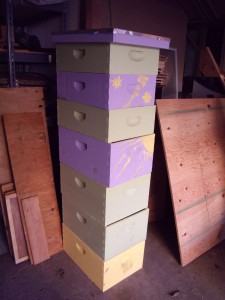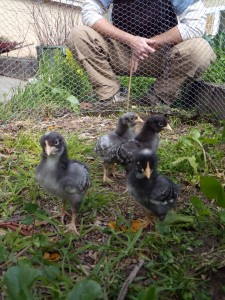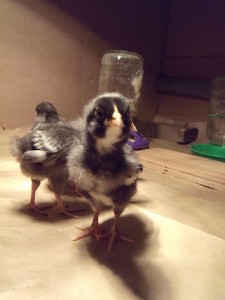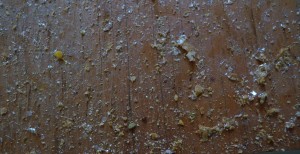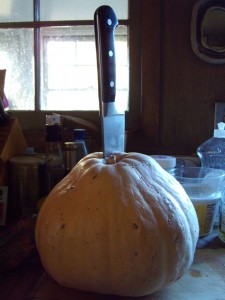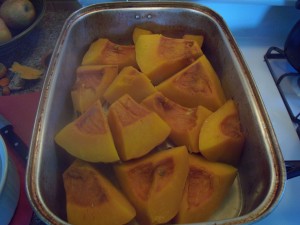
It's good to have friends to lean on at nap time.
In a fit of love-stricken spontaneity last Tuesday, Kelly and I drove half an hour to the nearest real farm supply store and brought home three week-old Barred Leghorn chicks. They cried in their box the whole way home and promptly fell asleep as soon as we got them set up under a heat lamp.
They did a lot of sleeping and pooping that night, and we hovered over their cardboard box, alternately cooing at them, guffawing at their baby antics, and fretting over their wellbeing. Let me just say now that neither of us really knows what we’re doing, and we’re both terrible worrywarts.
As it turned out, there was reason to be concerned. One of our new tinies (she currently answers to spotty, or spot-on-the-head) had a gob of dried poop partially blocking her vent. Fortunately, her concerned adoptive mothers did a little hasty Internet research and discovered that this is a potentially fatal condition in chicks known as pasting up, and that it is imperative to remove the offending gob regardless of how strongly the chick objects.
And so it was that Kelly and I found ourselves force-bathing an indignant ball of fluff at 11:45 PM on Valentine’s Day. As I suspected it would be, our chicken learning curve has already been a steep one. After dunking Spotty’s rear end in a bowl of warm water and gently picking off the poop, we blow dried her and returned her to her sisters.
Five chicken lessons from the first week
Since that first night, we haven’t had any emergencies, but we’ve learned a thing or two about our mini-chickens.
1. Chicks are noisy. The chick box is in the spare room, and though we keep the door closed, it’s easy to hear their near-incessant peeping through the night.
2. Chicks fall asleep the way people do on buses and in movie theaters. One of our greatest delights has been watching the chicks fall asleep. They can’t help themselves. A chick will suddenly stop pecking for food, and its little head will begin drifting downward, until the tip of its beak touches the ground. Then it will sink lower, and its cheek will press into the floor, and its little eyelids will flicker. And then, suddenly, it will jerk itself awake, shake off its nap, ruffle its feathers, and head off for a snack.
3. Chicks smell terrible. I think of baby animals as all having the same sweet, new-to-the-earth smell. Not so with chickens. Sometimes, when I touch my nose to one of their soft little heads, I almost think I catch a whiff of good baby smell, but then the overtones of nasty chicken poop drown it out. I’m here to say that chicken poop is one of the most offensive smelling forms of excrement I’ve ever come across. I wish I could believe I’ll get over my aversion to it in the coming seven weeks of indoor chickens, but I suspect it will only get worse as they grow and produce more of it.
4. Chicks grow fast. Really fast. By Wednesday afternoon, Kelly and I could both tell that the chicks had already grown. In the past few days their wings have developed considerably, and they now flap a few times as they run to get away from us in the box. They eat all the time, and it certainly seems to be paying off.
5. Chicks can make other pets (like cats) very jealous. Pudy seems to be torn between wanting to hunt them, feeling unnerved by them, and feeling abandoned and rejected by the humans in the house. Despite our best efforts to assure her that we still love her, and to introduce her (from a safe distance) to the chicks, she continues to slink around the house and claw the back of the sofa when we are in the chicken room.
A baby sister for the girls
This evening we’re headed back to the feed store to pick up the flock’s final member: a three-day-old Barred Rock chick. We hadn’t originally planned to get Leghorns; in fact Leghorns have a reputation for nasty temperaments (and phenomenal egg production!). Barred Rock birds are said to be very mild-mannered and friendly, as well as good egg-layers, so we figure she’ll be an excellent addition to the flock.


